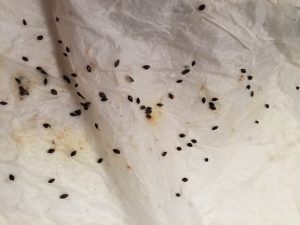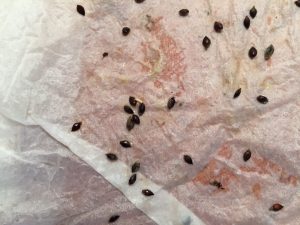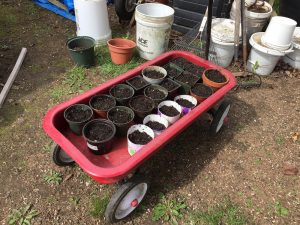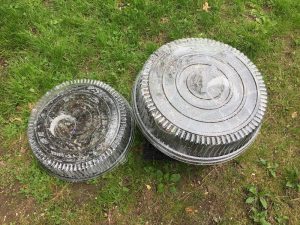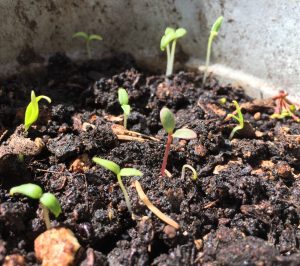Back on April 16th, I set up a germination experiment with about 300 Japanese indigo seeds from 2014. I put them between layers of wet paper towels inside a zip-lock bag and placed them on top of the hot water heater. It took a really long time for any of them them to sprout. Here’s what they looked like on April 24th:
Nothing had germinated, but there was a lot of gunky moldy stuff developing. I decided that more warmth was needed, and that they needed a fresh start. So I moved all the seeds to new wet paper towels, and rested them on top of a facecloth on the heater in the bathroom. We can close the door to the bathroom and keep the heat in. It would have been more efficient to have a seedling warming mat, but this method worked OK.
Here’s what they looked like on April 26th. Right in the center of this image is a little sprout:
By April 29th quite a few had sprouted. I was very excited, but the overall germination rate was terrible! Out of 310 seeds only 22 actually sprouted, which is about 7%. On the other hand, 22 is much better than nothing.
I potted them up on April 29th:
I put them in the wagon so I could pull them inside at night. For the first week of May we had a cool spell and it was very rainy. Not the best weather for tender starts. So, I scouted around for a way to create a make-shift greenhouse. Fortunately, that week our May Day celebration at school involved catering platters, so I was able to rescue a couple from the recycling bin and repurpose them:
It has worked pretty well so far. We put the platters out during the day and bring them in at night. Four pots didn’t fit, so they are just faring as well as they can in a milk-crate. As in previous years, our compost is full of tomatillo seedlings, but this year I was prepared for their emergence. On the left are some pots with a whole lot of seedlings, including tomatillos and a lone morning glory. On the right are the pots after weeding:
I am familiar enough with Japanese indigo seedlings now that I can tell them apart from the tomatillos. The Japanese indigo seedlings have pink stalks. Their leaves are rounder, more succulent-looking, and are a slightly darker shade of green. In this photo the leaves also have a pinkish tinge:
The Japanese indigo seedling is right in the center of the image above. My other identification trick was to place a single sprouted seed in the center of a pot, so I knew exactly where to look for emergence. So far, so good. If all goes well, I will have 22 Japanese indigo plants to transplant come June.

